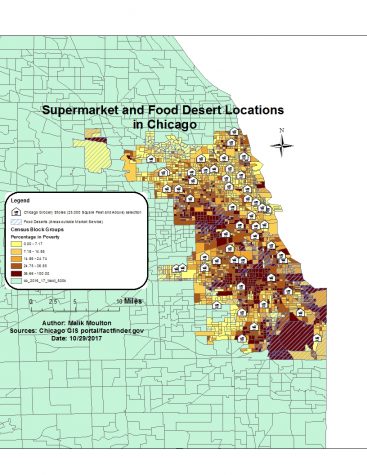Food Deserts: Its Injustice Behind Communities of Color
This food mart portrays the minimal access and lower quality food products that many communities struggle with within a food desert (https://en.wikipedia.org/wiki/File:Pronto_Food_Mart_on_CFB_Uplands.jpg).
October 29, 2020
As living organisms, food is indispensable. It fuels our energy; it constructs our muscles and bones and fat and skin and blood. It powers the pumping of our hearts and the goosebumps that peek through our skin. However, food is not only what enables us to survive, it allows us to live. Food is meant to be bountiful and shared, representing the unique cultures of all those around us. It is meant to drive strong bonds, communities, and societies. It is meant to be enjoyed and savored. It is not meant to suffice, rather satisfy. Naturally, when food is scarce and limited, it kills the spirit, energy, and bodies of those who are residents of that community. Food affects us beyond survival, food is life.
The Effects are Worsening
The HFFI (Healthy Food Financing Initiative) defines a food desert as a census tract that hosts a significant number of residents with inconvenient access to a proper food store (e.g., supermarket, grocery store). The U.S. government focuses primarily on census tracts with residents that receive an income that is 80% lower than average. Typically, residents that live in a food desert live more than one mile away from a grocery store with reasonable products in urban areas, and over 10 miles away in rural areas. 23.5 million people in the United States find themselves struggling in this onerous position. Further exacerbating, 10% of these individuals live in the same conditions, but do not own a vehicle. These numbers are absurd. The U.S. government should be making it a priority to reduce the number of food deserts and provide members of these communities with the support they need, such as by building more major chain supermarkets and grocery stores within these areas. Living surrounded by a neighborhood that does not promote healthy living forces an undeniable negative impact upon those who are housed in these areas, especially on young children. Growing up in this environment may cause many health problems to arise, especially later on in life.
According to the Harvard School of Public Health, healthy diets cost $1.50 more per day in comparison to an unhealthy diet. Food deserts host a copious amount of fast-food restaurants, selling cheap, insalubrious meat. Additionally, many of the foods that are sold are high in sugars, fat, and salt, which is detrimental to the body when consumed frequently at high amounts. Lack of food options makes it burdensome for some families to find culturally appropriate food items, along with food items that follow dietary restrictions (e.g. lactose intolerance). Furthermore, processed foods, such as chips and sodas, are also commonly sold at corner delis. Conspicuously, these food items are not healthy either and attract an audience of predominantly younger people. Over availability and exposure to unhealthy food products result in an elevated risk of children being diagnosed with childhood obesity in the United States.
Childhood obesity may cause countless health problems if the weight maintains as the children grow older. For instance, once obese children reach adulthood, they are eight times more likely to develop high blood pressure than adults that carried a normal weight as children. Children diagnosed with obesity are also more likely to acquire cardiovascular disease and type 2 diabetes. Unfortunately, according to the Bogalusa heart study, 77% of obese children remained obese as adults, meaning that these numbers are not in the favor of obese children losing weight. The children that grew up in food deserts, and were not given a chance to be surrounded by a neighborhood that supported or could afford healthy living, did not have an abundance of opportunities laid out in front of them. Unfortunately, an innumerable number of children were not given a better chance, and this issue is influencing their lives tremendously as they grow into adults.

Racial Composition is Taking Charge
Socioeconomic status is another dominant contributing factor to where food deserts are typically located. Low-income Black and Brown communities are where the preponderance of food deserts are detected. Native Americans, African Americans, and Latinos, overall, have more prevalent rates of diabetes and cardiovascular diseases because of the abundance of food deserts typically located in their communities. While children born in the year 2000 have a 1 in 3 risk of developing diabetes, Hispanic and African American children have a 1 in 2 risk of developing the same disease, according to the Bogalusa heart study. As stated by Kelly Bower, an assistant professor at the School of Nursing, “the poverty level of a neighborhood certainly matters, but even beyond poverty, the racial composition matters.” Ultimately, race and poverty are the two driving forces behind food deserts.
In census tracts with predominantly low-income minority communities, greater incongruencies with supermarket locations transpire, especially when compared to predominantly white neighborhoods. For instance, a 2012 study by the NYU School of Law found that Detroit, Michigan is comprised of 83% African Americans, and 6% Latino residents. Because this city houses primarily minority communities, a major supermarket chain has not been built. Further, comparing predominantly African-American communities to their white counterparts in Los Angeles suggests that in white neighborhoods, there are 3.2 times as many supermarkets than there are found in African-American neighborhoods and 1.2 times more than there are found in Latino neighborhoods.
Minority neighborhoods should not be receiving poorer quality environments in comparison to their white counterparts. The fact that a greater number of food deserts lie within communities of color is not a demographic accident, nor a result of settlement patterns. U.S. government policies have led to this disparity. Local politicians should be finding ways to implement convenient grocery stores with healthy and affordable food options, bestowing minorities with opportunities to better their health. It is completely unjust that the racial composition of a community influences access to a basic human necessity. Minority communities receiving worse treatment than their white counterparts is something that must receive more attention to be rectified. It has become transparent that food deserts serve as a public health risk to communities of color. It is imperative for community leaders and politicians to take action.




